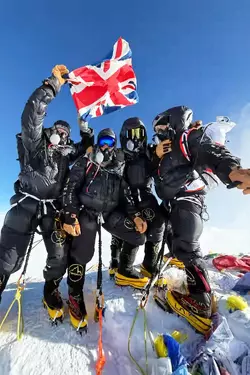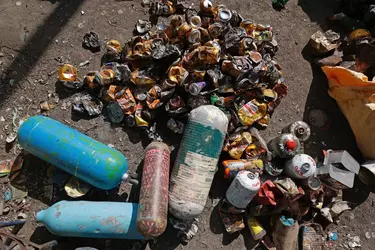A group of British men went from London to the summit of Everest and back in less than a week with the help of xenon gas. Mountaineers and the Nepalese government weren’t pleased.

Four British climbers pose on the summit of Mount Everest on Wednesday after preparing for the climb with xenon gas.
By Jonathan Wolfe and Bhadra Sharma
May 27, 2025
Climbing Mount Everest typically takes weeks, with most of that time spent at the foot of the mountain adjusting to the thin air. But four British men last week shrank that timeline dramatically, traveling from London to the summit and back in less than a week, according to the organizer of their expedition.
They skipped the adjustment period, in part, by inhaling a secret weapon: xenon gas.
Their feat has roiled the world of mountaineering and prompted an investigation by the Nepalese government, as use of the gas is fiercely debated. Some research has shown that xenon can quickly acclimatize people to high altitudes, even as some experts say the benefits, if any, are negligible and the side effects of its use remain unclear.
Organizers said the gas was key to the speed of the climb, but their approach has prompted a broader debate that strikes at the core of mountaineering: Should scaling Mount Everest, one of sporting’s greatest accomplishments, be made easier — available to more people during a quick vacation — with the help of a performance enhancer?
“It is a provocation, especially for traditional mountaineers, who feel bad about this idea that you can climb Everest in less than a week,” Lukas Furtenbach, who organized the exhibition, said in a phone interview from the base of the mountain. “This showed that it can work.”
Mr. Furtenbach said that beginning in 2026 he planned to offer two-week round-trip excursions to Mount Everest using xenon gas, cutting the typical time needed to scale the mountain by several weeks.
“This can be the future of commercially guided mountaineering on Mount Everest,” he said.
With Xenon, ‘you feel better.’
For those who live at lower elevations and have traveled to the mountains, the discomfort of altitude sickness is all too clear. Symptoms include nausea, headaches and disrupted sleep, and in some cases it can lead to brain swelling, or even death.As you go higher, less oxygen is absorbed into the bloodstream with each breath. That is why so many people who climb Everest use supplemental oxygen.
Xenon, an odorless gas, has been known for years to activate a molecule called the hypoxia-inducible factor, which is also turned on when people acclimate to low oxygen, said Hugh Montgomery, a professor of intensive care medicine at University College London and a mountaineer who led an expedition to Mount Everest to study how humans respond to low oxygen.
“So what these people claim to have done,” he said, “is basically found a way to switch on the adaptation to low oxygen levels.”

Used oxygen cylinders and cans collected en route to Mount Everest at a waste facility in Kathmandu, Nepal, last year.
The group took what was known from medical science, he said, “and have now applied it, recreationally, to sport mountaineering.”
Professor Montgomery said scientists were still unsure how xenon triggers this response.
While some doctors have used the gas in the past to “precondition” patients to low oxygen levels — for example, before major heart surgery — the practice hasn’t really caught on because “it hasn’t been as protective as one would hope,” he said.
Mike Shattock, a professor of cellular cardiology at King’s College London, said “xenon probably does very little and there is virtually no reputable scientific evidence that it makes any difference.”
Experts also cautioned that self-medicating with xenon, which has the effects of anesthesia, could lead to overdose or death, and more study was needed to understand how the gas works and its use in mountaineering.
On Mount Everest, the weeks of training and acclimation on the lower levels of the mountain are typically required to survive the “death zone,” the area above 26,000 feet where the air is particularly thin.
The British group, which included four former special forces members, took a different approach.
About 10 weeks before the expedition, the men began sleeping in hypoxic tents, which lower oxygen levels in the air and gradually acclimatized the hikers to conditions on Mount Everest, Mr. Furtenbach said.
While hypoxic tents have been used by some climbers for years, the big innovation for the British expedition came two weeks before the excursion, when the men flew to Limburg, Germany, outside Frankfurt, where a doctor, Michael Fries, had been experimenting with inhaled gases in his clinic.
The men wore masks hooked up to ventilators as an anesthesiologist slowly introduced higher levels of xenon into their systems.
Mr. Furtenbach, who has tried xenon gas on his own mountaineering trips since 2020, said that after the treatment, users experienced enhanced breathing and the sensation of more lung volume, and “when you do your workout or training, you feel better.”
After arriving at the base of Everest, the British group climbed to the summit in less than three days, which Mr. Furtenbach said was one of the fastest times for a group that hadn’t acclimatized on the mountain. (According to the Nepalese government, the record for the fastest climb overall is held by Lakpa Gelu, a Sherpa, who reached the top of the mountain in just under 11 hours.)
The rapid climb by the British expedition and the use of the gas caught the eye of the Nepalese government, and the fallout has been swift.
The use of the gas is ‘against climbing ethics.’
Himal Gautam, the director of Nepal’s tourism department, which is responsible for regulating expeditions on the nation’s mountains, said in an interview that using the gas was “against climbing ethics,” and that it would hurt the country’s tourism industry and the Sherpas who help climbers by reducing their time on the mountain.Mr. Gautam said his department was looking into the use of the gas by the British climbers, one of whom, Alistair Carns, is also a member of Parliament.
In an interview, Mr. Carns said that his expedition had been in touch with the ministry, and clarified with the department that it had not taken the gas on the mountain.
He added that many people who want to climb Mount Everest don’t have the time to spend multiple weeks acclimating.
“The reality is if I had six to eight weeks to climb Everest, I would, but I’m a government minister and I don’t have time,” he said. “What we’ve done is we’ve proven that you can reduce the timeline safely.”
Others in the mountaineering community have warned against the use of the gas.
In January, the International Climbing and Mountaineering Federation, a global network that promotes and protects the sport, released a statement that said there was no evidence that xenon gas improved performance, adding that “inappropriate use can be dangerous.”
The federation noted that xenon has been on the World Anti-Doping Agency’s list of banned substances since 2014 and is not approved in all countries.
“From a medical point of view, off-label use without a scientific basis and with unknown health risks must be rejected,” the statement said.

The area of Everest Base Camp in Nepal earlier this year.
Mr. Furtenbach argued that his expeditions were still using Sherpas — five accompanied the British climbers to the summit — and that shorter times on the mountain were safer, as they reduce the chance that climbers will be exposed to other health threats, including avalanches, hypothermia or falls.
He said the prohibition of the gas by the World Anti-Doping Agency didn’t apply to mountaineering because it is not a regulated competitive sport.
Use of the gas gets at a core question about why people climb big hills in the first place, Professor Montgomery said.
“Is it really a good idea that we can all have what we want, when we want, as quick as we want?” he asked. “Are we missing out on the sacrifice you sometimes have to make to get the achievement?”
“I’m not a critic,” he added. “But maybe just bagging every hill at speed means you miss out on the joy you could have had.”
Associated Press: Renowned Everest guide says using xenon speeds climb and makes it safer, better for environment (archive)


Mountain guide Lukas Furtenbach speaks with Associated Press during an interview in Kathmandu, Nepal, Monday, May 26, 2025.
By BINAJ GURUBACHARYA
May 26, 2025
KATHMANDU, Nepal (AP) — Using xenon gas treatment and the latest technology is making climbing Mount Everest not just faster but also better for the environment, cutting down garbage and waste, a renowned mountain guide said Monday.
Lukas Furtenbach took a team of British climbers, who left London on May 16, to scale the 8,849-meter (29,032-foot) peak on May 21. They returned home two days later, in one of the fastest ascents on record of the world’s highest peak, including the climbers’ travel from their homes and back.
The use of xenon gas treatment has, however, drawn controversy and has even raised the concerns of Nepalese mountaineering authorities who have announced an investigation.
“The only reason why we are working with xenon is to make climbing safer, to protect climbers from high altitude sickness,” Furtenbach told The Associated Press upon his return to Kathmandu. “We can see people dying on Everest every year and this is may be one step to improve the situation to make climbing high altitude mountains safer.”
The climbers had put in months of preparation, training in hypoxia tents, and underwent a xenon gas treatment at a clinic in Germany just two weeks before heading to Nepal.
Climbers normally spend weeks at base camp to acclimatize to the higher altitude. They make practice runs to the lower camps on Everest before beginning their final attempt on the peak so that their bodies are prepared for the low pressure and lower level of oxygen available.
The new method is likely to reduce the time climbers spend out of their home countries and cut the number of days they need to take off work, also cutting down on expenses.
Furtenbach said the ability to climb the peak in a short period of time could also lead to less environmental impact on the mountain.
“Human waste is one of the biggest problems on Everest base camp. If people spend one week there compared to eight weeks, it is a 75% reduction of human waste,” he said. “It is a huge reduction of garbage on the mountain and also of resources that have to be carried up to the back camp and have to be carried up the mountain.”
Nepal doesn’t have rules on how many days climbers must spend acclimatizing or making practice climbs. The permits to climb Everest, which cost $11,000 each, are valid for 90 days. Climbing season normally wraps up by the end of May, when the weather deteriorates and monsoon season begins. The ropes and ladders fixed to the mountain are then pulled out.
Nepal’s mountaineering department issued a press statement saying it was going to investigate the use of xenon gas.
Furtenbach said the gas was never used in Nepal and that he could prove that it was safe to use for climbers.
